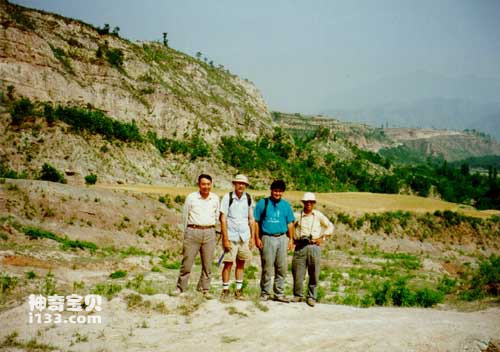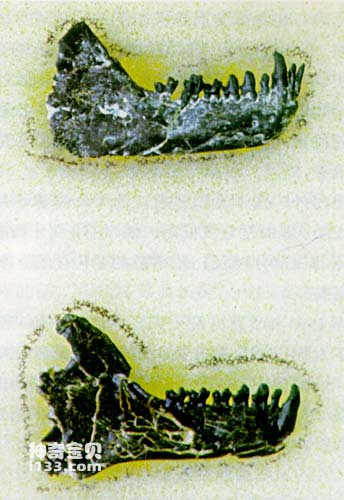Some scholars at home and abroad believe that E. sinensis is not a higher primate. The reason is that it shows many primitive characteristics than those early higher primates in Africa, and its materials are not complete enough. However, it didn’t take long for the discovery of Auroantium genus in the Yuanqu Basin of Shanxi Province to add a heavy weight to the Chinese side of the balance regarding the origin of higher primates.

Tong Yongsheng [right] and others excavated in Yuanqu

Wang Jingwen [right], Huang Xueshi and others inspected Yuanqu
The Yuanqu Basin is the birthplace of research on Early Tertiary strata and paleomammals in China. However, many of its important fossil sites are now submerged under the blue waves of the Xiaolangdi Reservoir. In 1993, the Institute of Vertebrate Paleontology and Paleoanthropology organized an expedition team headed by paleontology expert Wang Jingwen to prepare for rescue excavations at these fossil sites. However, due to lack of funds, they had to seek help from foreign counterparts.

Guo Jianwei rested in front of a farmer's cave dwelling during his inspection
It’s the Carnegie Museum of Natural History again! Mary Dawson and Christopher Beard realized the importance of these fossil sites. With limited funds, they organized a large team including paleontologists, geologists and paleomagnetologists, and established a joint venture with researchers such as Wang Jingwen, Tong Yongsheng, Huang Xueshi and Guo Jianwei from the Institute of Vertebrate Paleontology and Paleoanthropology. A joint expedition team was formed and conducted field expeditions for four seasons from 1994 to 1997.

Fossils of Auroantium
The joint expedition team achieved fruitful results and unearthed a large number of vertebrate fossils; among them, in May 1995, an almost complete mandible of Eunapithecus with almost all teeth was unearthed. It is slightly larger than E. sinensis, and comparable parts are obviously very similar. In a series of traits, it shows the characteristics of higher primates, mainly in: (1) The mandibular symphysis is short anteroposteriorly and dorsally and ventrally deep; (2) the lower incisors grow vertically; (3) the canine teeth are large and protruding; (4) The enlarged portion of the lateral cusp base of the last two premolars is slightly inclined in the dentition; (5) the triangular seat of the last molar is wider than the base; (6) the labial-lingual surface of the last molar and Mid-distal recession; (7) The mandibular angular process is rounded, thus providing a larger attachment area for the pterygoid muscles. At the same time, it also shows some other traits that are more primitive than all other higher primates, and these primitive traits show its similarity to the ancient tarsiers, thus providing the first mirror for higher primates. The monkey origin theory provides certain evidence. It was named Century Auroantium; the associated fauna was called the Naduqi Zhaili Mammal Fauna, and its age was the latest period of the Middle Eocene, about 40 million years ago.
Shortly thereafter, Tong Yongsheng discovered the upper and lower teeth of a similar species of Aopithecus in the slightly earlier Salamulun period upper river mammal group in the Yuanqu Basin.
animal tags:
We created this article in conjunction with AI technology, then made sure it was fact-checked and edited by a Animals Top editor.